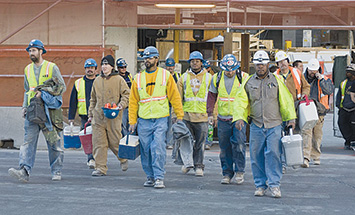Data Shows Unions Producing Better Outcomes for Workers, Worksites, and Public Budgets

La Grange, IL – Illinois workers earn higher wages, deliver higher levels of productivity, are more likely to have health insurance, and are substantially less likely to suffer workplace fatalities than comparable workers in states that have taken policy actions to weaken unions and erode collective bargaining rights, according to a new study from the nonpartisan Illinois Economic Policy Institute (ILEPI) and the Project for Middle Class Renewal (PMCR) at the University of Illinois at Urbana-Champaign.
The research comes as Illinois voters are set to weigh in on the Workers’ Rights Amendment, a November ballot question that would enshrine the right to unionize in the Illinois Constitution and prevent passage of any state law or local ordinance “that interferes with, negates, or diminishes the right of employees to organize and bargain collectively.”
WOULD BAN ‘RTW’
The 1935 National Labor Relations Act first established a federal right to organize unions. However, the passage of the Taft-Hartley Act of 1946 gave states the ability to weaken these institutions. Twenty-seven U.S. states have since enacted policies to erode worker bargaining power by passing so-called “right-to-work” or “free rider” laws that require unions to provide representation to workers who refuse to pay for services.
Former Illinois Governor Bruce Rauner proposed a similar measure in 2017, though it failed to win passage in the General Assembly.
In analyzing the Workers’ Rights Amendment’s potential impacts on Illinois, researchers compared economic and workforce outcomes between union and nonunion workers across the state, as well as between Illinois and the 27 states that have passed state laws to weaken unions.
BETTER FOR WORKERS AND PUBLIC BUDGETS
“Our analysis reveals that unions not only deliver higher wages and better benefits for Illinois workers relative to their nonunion peers, but that they are substantially better for public budgets,” said ILEPI Executive Director and study coauthor Frank Manzo IV.
Analyzing two decades worth of data from the American Community Survey, the study found that union workers in Illinois earned 14 percent higher incomes on average, were about 10 percent more likely to have health insurance, paid more in state and federal taxes, and were half as likely to live in poverty or rely on government assistance as comparable nonunion workers.
‘A RISING TIDE LIFTS ALL BOATS’
By examining additional American Community Survey, Bureau of Labor Statistics, and Bureau of Economic Analysis data, researchers were able to compare Illinois on other economic metrics to states that have weakened collective bargaining rights — and to assess the potential impact of the Workers’ Rights Amendment on additional variables ranging from workplace safety to rates of homeownership.
“It’s no secret that a rising tide can lift all boats,” added ILEPI Research Associate and study coauthor Grace Dunn. “The data shows that Illinois’ longstanding commitment to collective bargaining has contributed to better outcomes for all workers—delivering safety, workforce productivity and job quality metrics that far exceed the averages in states that have chosen to weaken collective bargaining.”
As significant as the labor market differences were between Illinois and states that had weakened their collective bargaining laws, researchers noted that there were especially large differences in occupational categories currently facing labor shortages and deemed essential during the COVID-19 pandemic.
BETTER LABOR MARKET OUTCOMES
“The freedom to unionize has clearly contributed to comparably better labor market outcomes for all Illinois workers,” said PMCR Director, study coauthor, and University of Illinois at Urbana-Champaign Professor Dr. Robert Bruno.
“That said, in the wake of a deadly pandemic that’s left many industries facing labor shortages, the data shows that the Workers’ Rights Amendment will also help promote the job quality needed to attract and retain workers in the most critical sectors of our economy.”
Ultimately, by preventing state politicians from enacting future laws that would weaken union rights, researchers predicted the Workers’ Rights Amendment could play an important role in protecting the state’s relatively higher wages, benefits, and safety standards.
“At a time when Americans don’t seem to agree on much, public polling has shown historic levels of bipartisan support for unions and the protection of collective bargaining rights,” Manzo concluded. “Our study shows that these opinions are not only well-founded, but they are also overwhelmingly supported by real-world economic data.”


